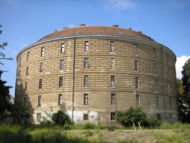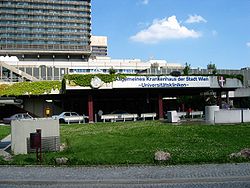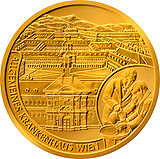
Vienna General Hospital
Encyclopedia







Hospital
A hospital is a health care institution providing patient treatment by specialized staff and equipment. Hospitals often, but not always, provide for inpatient care or longer-term patient stays....
of the city of Vienna
Vienna
Vienna is the capital and largest city of the Republic of Austria and one of the nine states of Austria. Vienna is Austria's primary city, with a population of about 1.723 million , and is by far the largest city in Austria, as well as its cultural, economic, and political centre...
, Austria
Austria
Austria , officially the Republic of Austria , is a landlocked country of roughly 8.4 million people in Central Europe. It is bordered by the Czech Republic and Germany to the north, Slovakia and Hungary to the east, Slovenia and Italy to the south, and Switzerland and Liechtenstein to the...
. The AKH is the largest hospital
Hospital
A hospital is a health care institution providing patient treatment by specialized staff and equipment. Hospitals often, but not always, provide for inpatient care or longer-term patient stays....
of Austria and Europe, the second largest hospital in the world, and at 85-m (279-ft) high is one of the tallest hospital buildings in the world. It is also the site of the Medical University of Vienna
Medical University of Vienna
The Medical University of Vienna is a medical university in Vienna, Austria.Formerly the faculty of medicine of the University of Vienna, became an independent university on January 1, 2004...
.
Old AKH
The origins of Vienna General Hospital go back to Dr. Johann Franckh, who donated properties, in 1686, after the end of the second Viennese-Turkish warGreat Turkish War
The Great Turkish War refers to a series of conflicts between the Ottoman Empire and contemporary European powers, then joined into a Holy League, during the second half of the 17th century.-1667–1683:...
, at the corridor Schaffernack for the establishment of a military hospital. However, since money was lacking for the establishment of the buildings, the disabled veterans were quartered, including families, in the Kontumazhof (epidemic hospital), already in existence. In 1693, Emperor Leopold I
Leopold I, Holy Roman Emperor
| style="float:right;" | Leopold I was a Holy Roman Emperor, King of Hungary and King of Bohemia. A member of the Habsburg family, he was the second son of Emperor Ferdinand III and his first wife, Maria Anna of Spain. His maternal grandparents were Philip III of Spain and Margaret of Austria...
arranged the establishment of the large hospital. In 1697, the first ward was finished, into which 1042 persons were quartered.
In 1724, 1740 persons were already living there. Extending the complex was made possible by the will of Ferdinand Baron von Thavonat, who donated his possession after his death in 1726 to disabled soldiers. The marriage or widow yard, now Thavonathof, was to be finished. Also, the side yards formed by Zwischentrakte, the patient yard (4.), Restaurant economics (5.) and craftsman center (7.) were established.
During 1752 to 1774, further development occurred for the student yard (3.) and the house supervisor yard (6.). The inhabitants had to wear their own uniforms and received individual copper coins, which could be redeemed with the bakers in the complex, butchers, etc. The dissolution of the neighbouring cemetery came finally in 1834 of the 8th and 9th wards, in addition.
On January 28, 1783, Emperor Joseph II
Joseph II, Holy Roman Emperor
Joseph II was Holy Roman Emperor from 1765 to 1790 and ruler of the Habsburg lands from 1780 to 1790. He was the eldest son of Empress Maria Theresa and her husband, Francis I...
had visited the poorhouse. He stated the fact that the enormous plant served less the Notlinderung but often people accommodated, which had arrived there under protection or Schlamperei. Professor Dr. Joseph Quarin
Joseph von Quarin
Joseph von Quarin was an Austrian physician who was a native of Vienna. In 1754 he became a university professor at Vienna, where he was appointed rector six times during his career....
, who later became director, used a general hospital plan.
On August 16, 1784, the opening took place. The hospital was responsible initially only for the attendance of patients; the remaining tasks of the hospitals were separate. To the hospital were attached a bearing house, a Findelhaus, and a lunatic asylum. The Narrenturm was the first special building for the accommodation of mental patients.
Particularly in the 19th century, Vienna General Hospital was the center of the Viennese Medical School, as one of the centers of medical research. Thus Ignaz Semmelweis
Ignaz Semmelweis
Ignaz Philipp Semmelweis was a Hungarian physician now known as an early pioneer of antiseptic procedures. Described as the "savior of mothers", Semmelweis discovered that the incidence of puerperal fever could be drastically cut by the use of hand disinfection in obstetrical clinics...
made his observations of hygiene
Hygiene
Hygiene refers to the set of practices perceived by a community to be associated with the preservation of health and healthy living. While in modern medical sciences there is a set of standards of hygiene recommended for different situations, what is considered hygienic or not can vary between...
, and Karl Landsteiner
Karl Landsteiner
Karl Landsteiner , was an Austrian-born American biologist and physician of Jewish origin. He is noted for having first distinguished the main blood groups in 1900, having developed the modern system of classification of blood groups from his identification of the presence of agglutinins in the...
discovered at the AKH the groups of blood types.
On the site of the old AKH, are since removal, the medical institutes of the Campus of the University of Vienna
University of Vienna
The University of Vienna is a public university located in Vienna, Austria. It was founded by Duke Rudolph IV in 1365 and is the oldest university in the German-speaking world...
with numerous mental-scientific institutes as well as several catering trade enterprises and smaller enterprises.

The synagogue
The synagogueSynagogue
A synagogue is a Jewish house of prayer. This use of the Greek term synagogue originates in the Septuagint where it sometimes translates the Hebrew word for assembly, kahal...
in the old AKH Vienna was established in 1903 by the architect Max Fleischer as the "praying pavilion" for patients of Jewish faith. The synagogue was heavily devastated during the Third Reich
Nazi Germany
Nazi Germany , also known as the Third Reich , but officially called German Reich from 1933 to 1943 and Greater German Reich from 26 June 1943 onward, is the name commonly used to refer to the state of Germany from 1933 to 1945, when it was a totalitarian dictatorship ruled by...
's Kristallnacht
Kristallnacht
Kristallnacht, also referred to as the Night of Broken Glass, and also Reichskristallnacht, Pogromnacht, and Novemberpogrome, was a pogrom or series of attacks against Jews throughout Nazi Germany and parts of Austria on 9–10 November 1938.Jewish homes were ransacked, as were shops, towns and...
in 1938, and further destroyed when converted after the war, in 1953, into a transformer
Transformer
A transformer is a device that transfers electrical energy from one circuit to another through inductively coupled conductors—the transformer's coils. A varying current in the first or primary winding creates a varying magnetic flux in the transformer's core and thus a varying magnetic field...
station. In 2005, the remains of the building was restored to become the Marpe Lanefesch Memorial.
The Narrenturm (Fool's Tower)
In the old AKH stands the first building worldwide for the accommodation of mental patients, established in 1784 under Emperor Joseph II by Isidore Canevale; it is today the seat of the pathological-anatomical federal museum of Vienna. The building consisted of a five-part fortress-like circular building with slot-like windows for 200 to 250 mental patients. In its strict geometrical form and austerity, the building is considered as a high point of the revolution classicism. Each cell had strong latticeLatticework
Latticework is a framework consisting of a criss-crossed pattern of strips of building material, typically wood or metal. The design is created by crossing the strips to form a network...
doors and rings for chaining unrestrained patients. Ten years later, the tower was already completely outdated due to innovations in the therapy for mental patients. From its round form is derived the usual colloquial designation in Vienna, Gugelhupf, meaning a round Austrian cake. The notion that the Fool's Tower is a conversion of the idea of the Panopticon
Panopticon
The Panopticon is a type of building designed by English philosopher and social theorist Jeremy Bentham in the late eighteenth century. The concept of the design is to allow an observer to observe all inmates of an institution without them being able to tell whether or not they are being watched...
of Jeremy Bentham
Jeremy Bentham
Jeremy Bentham was an English jurist, philosopher, and legal and social reformer. He became a leading theorist in Anglo-American philosophy of law, and a political radical whose ideas influenced the development of welfarism...
does not apply, since the cells are not controllable from a central observation post.
Already at the oldest model, the Fool's Tower has at the roofridge a lightning rod
Lightning rod
A lightning rod or lightning conductor is a metal rod or conductor mounted on top of a building and electrically connected to the ground through a wire, to protect the building in the event of lightning...
or a Blitzfänger. Two of its mounting plates in the inner court still exist. Independently of Benjamin Franklin
Benjamin Franklin
Dr. Benjamin Franklin was one of the Founding Fathers of the United States. A noted polymath, Franklin was a leading author, printer, political theorist, politician, postmaster, scientist, musician, inventor, satirist, civic activist, statesman, and diplomat...
, who invented the lightning rod in 1753,
the minister of Primetice, Czech inventor Prokop Diviš, in 1754, built the first worldwide grounded lead in his garden.
Josef II knew well the attempts of Divis, which specifically concerned an assumed health benefit from currents. Whether the lightning conductors were used for the treatment of the patients has not been clarified.
New AKH
With time, the Joseph-era buildings of the general hospital became unwieldy, so in 1957, it was decided to establish a new large central hospital. The building of the new AKH was begun in the summer of 1964. At the beginning, the personnel hostels and the university clinics for child medicine were moved. In 1974, the building of the main house was begun. This consists of an outpatient clinic and OI area (approx. 50 OI halls) and two large, 22-floor high bed towers, which accommodate 2,199 beds.The AKH is connected with its own underground (train) station (U6 Michelbeuern/AKH) to the public transportation network. The Zentralbau with the bed towers was officially opened in 1994, but already used (partly) since 1991. The total construction costs are equivalent, in 2004 values, to approximately 4.5 billion euro
Euro
The euro is the official currency of the eurozone: 17 of the 27 member states of the European Union. It is also the currency used by the Institutions of the European Union. The eurozone consists of Austria, Belgium, Cyprus, Estonia, Finland, France, Germany, Greece, Ireland, Italy, Luxembourg,...
, projected as 1 billion Schilling
Austrian schilling
The schilling was the currency of Austria from 1924 to 1938 and from 1945 to 1999, and the circulating currency until 2002. The euro was introduced at a fixed parity of €1 = 13.7603 schilling to replace it...
(72.67 million euro originally). The construction costs are carried together by the city of Vienna and the Austrian federation. The cost explosion and an associated bribery affair with the building of the new AKH led to the AKH scandal, the largest Austrian building scandal. Moreover, the Austrian magazine ECO
Eco
- Eco may refer to :* eco-, a prefix mostly relating to ecological or environmental terms* .eco, , a proposed top-level domain for the Internet* Eco , a proposed currency* Eco , a computer simulation game...
reported that only 60% of the AKH was used, and was thus planned much too large. The unused (however completely equipped) part stands completely empty.
At present, about 9,000 people are employed at the AKH. Of these, approximately 1,600 physicians and 4,500 allied health and nursing workers attend to patients. Annually, nearly 95,000 people are treated as inpatients, and another half-million attend the hospital's 384 outpatient clinics. Over 11,000 students are registered at the Medical University of Vienna
Medical University of Vienna
The Medical University of Vienna is a medical university in Vienna, Austria.Formerly the faculty of medicine of the University of Vienna, became an independent university on January 1, 2004...
.
See also
- The hospital was recently selected as a main motif for a high value collectors' coin: the Austrian €50 Ignaz Philipp Semmelweis commemorative coin. The reverse has a wide view of the old General Hospital in Vienna, where SemmelweisIgnaz SemmelweisIgnaz Philipp Semmelweis was a Hungarian physician now known as an early pioneer of antiseptic procedures. Described as the "savior of mothers", Semmelweis discovered that the incidence of puerperal fever could be drastically cut by the use of hand disinfection in obstetrical clinics...
was stationed in the childbirth clinic. - Hofburg - Royal court buildings during the time period.

